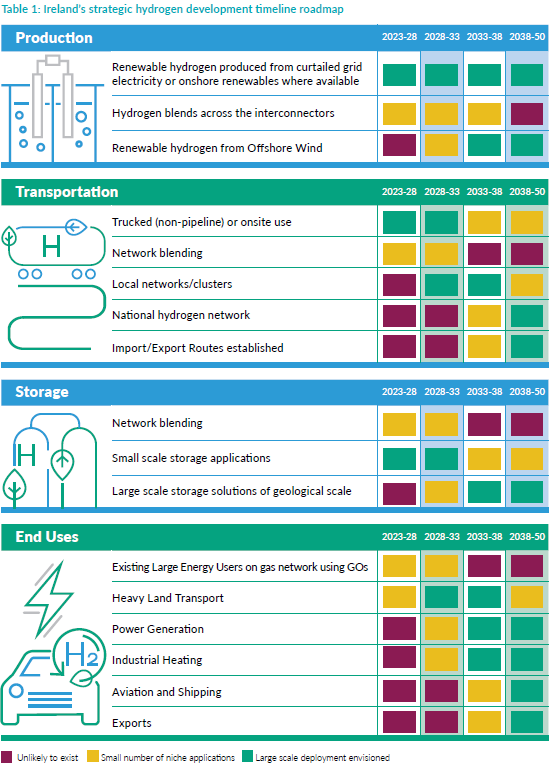Ireland can be an energy powerhouse with green hydrogen potential from renewables
The Minister for the Environment, Climate and Communications, Eamon Ryan TD, has today welcomed the publication of the National Hydrogen Strategy. The strategy represents a landmark point in the development of a renewable hydrogen sector in Ireland.
Ireland has the natural resources to become a world leader in the production of green energy. Our wind resources are amongst the best in the world. Hydrogen represents one of the best ways of capturing these resources. If Ireland can harness the opportunities offered by renewable hydrogen, we can achieve our goals of a zero-carbon, secure energy system and potentially become an exporter to the emerging hydrogen markets establishing across Europe. Ireland has recently signed an agreement with Germany to supply “green hydrogen” from what is regarded internationally as our significant renewable energy potential.
Renewable hydrogen is zero-carbon fuel that can play a key role in the “difficult-to-decarbonise” sectors of our economy where other solutions such as direct electrification are not feasible or cost effective. In the coming years, renewable hydrogen is envisioned to play an important role as a zero-emission source of dispatchable, flexible electricity, as a long duration store of renewable energy, in decarbonising industrial processes, and as a transport fuel in sectors such as heavy goods transport, maritime and aviation.
There have been 21 short-term actions identified within the strategy to enable the development of the hydrogen sector in Ireland. These actions aim to remove any barriers which could inhibit early hydrogen projects from progressing today, and to enhance our knowledge through targeted research and innovation across the hydrogen value chain, laying the groundwork to deliver on our long-term strategic vision for hydrogen in Ireland.
Ireland will focus its efforts on the scale up and production of renewable “green” hydrogen as it supports both our decarbonisation and energy security needs. Prior to 2030, hydrogen production will target grid-connected electrolysis from surplus renewables.
A 2GW target to produce renewable hydrogen sourced from offshore wind is also set to be in development by 2030, which will help to provide greater certainty for investors and create the scales needed to enable greater infrastructure deployment.
Speaking about the strategy, Minister Ryan said:
“The National Hydrogen Strategy is our first major policy statement on renewable hydrogen and marks an important first step in developing an indigenous hydrogen sector in Ireland.
“Our wind resources are amongst the best in the world. Using these resources to create hydrogen, and targeting it towards those sectors which are considered hard to decarbonise, will be integral part in ensuring the decarbonisation and security of our energy system into the future. Ireland can become a green hydrogen powerhouse from our renewable energy potential.”
The strategy sets out our strategic vision for the role that hydrogen will play in Ireland’s energy system and as a key component of our zero-carbon economy.
The National Hydrogen Strategy considers the needs of the entire hydrogen value chain, including production, end uses, transportation and storage, safety, regulation, markets, innovation, and skills.
To view and download the National Hydrogen Strategy, please gov.ie – National Hydrogen Strategy (www.gov.ie)
Hydrogen
Hydrogen is the most abundant element in the universe. Given its small molecular size it is normally found chemically bonded to other elements, primarily water (H2O) and hydrocarbons (CxHx). Producing hydrogen requires these chemical bonds to be broken down and the hydrogen to be separated and stored. Doing so requires an energy input, typically in the form of electricity or heat. The source behind this energy input, and the resulting by-products from the process influence how carbon intensive the hydrogen production process is.
Most hydrogen produced globally today is fossil fuel based “grey” hydrogen, meaning it has been produced from hydrocarbons without any emissions abatement of the carbon by-product. This is a carbon intensive and non-sustainable form of production. Given the strategic role envisioned for hydrogen in Ireland is primarily to support the delivery of an integrated net zero energy system, it is essential that hydrogen production supports this long-term goal. The relevant sustainable production pathways for Ireland are discussed in more detail in the National Hydrogen Strategy.
